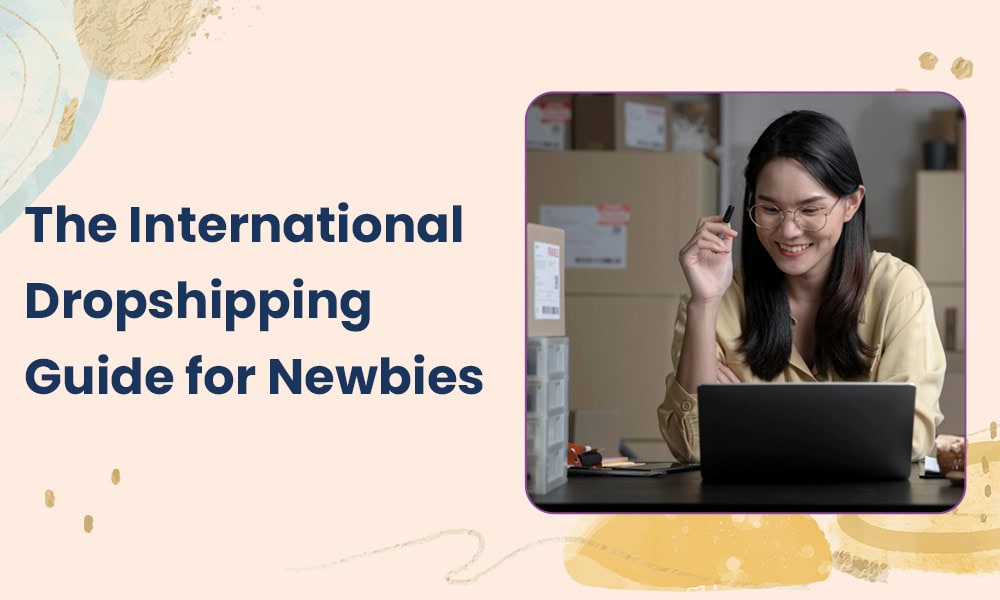Have you always longed to take your eCommerce business overseas, but the logistics and expenses were so complex they made your head spin? Well, my friend, you should look into international dropshipping.
You can expand your customer roster and deepen your bottom line working anywhere on this vast blue globe.
And while dropshipping is lower-risk and easier to implement than expanding overseas with other order fulfillment models, I’d be remiss to act like it’s completely uncomplicated.
There are challenges to be aware of.
However, you don’t need to sweat it. In this blog post, I’ll help you prepare for all the hurdles that can appear as you begin your international dropshipping venture. I’ve also got actionable solutions you won’t want to miss.
Table of Contents
Key Takeaways
- International dropshipping is an excellent way to grow your online business, but it comes with challenges, such as shipping difficulties, language barriers, more currency support, logistics planning, and understanding the legal regulations and tax rules.
- Preparation and strategic planning are your two best bets for success in international dropshipping. Using innovative practices and modern technology for better efficiency will also help.
Understanding International Dropshipping
First, let’s rewind and discuss international dropshipping and how it works.
So, in a nutshell, international dropshipping allows for order fulfillment all over the world. As the merchant, your business would work with suppliers and warehouses strategically stationed to ship out orders across seas and continents.
Since it’s dropshipping, you don’t need to worry about stocking products yourself; that’s the dropshipping supplier’s job. You must forward the order to your supplier and wait until you receive your sale cut.
While international and domestic dropshipping are similar in many ways, there are unique considerations once you branch into foreign waters.
Take a look.
Number of suppliers
If you operate in a single country, you can make a successful domestic dropshipping business model with only one supplier. However, one supplier per destination country will no longer be cut off upon expansion into international territory.
You might not need one for every country you supply to, but you will need a small team of suppliers.
The implications of working with more suppliers mean the need always to be connected, as you can’t leave any of your suppliers hanging. They will also each take their cut, so you must realistically build that into your financial projections.
Warehousing and inventorying
The more customers you have, the more orders you get, which means you need quite a lot of warehousing space if you hope to be successful at international dropshipping. Of course, since you’ll have more suppliers, warehousing should be taken care of.
Another concern built into warehousing is managing the right inventory level. You don’t want stockouts because your supplier doesn’t have enough inventory, yet at the same time, you don’t want so much that it sits and doesn’t sell.
Shipping speed
The biggest detriment of dropshipping is the slow shipping speed, even domestically. You can expect even slower speeds once you add global services to the mix than usual. I’ll talk more about why that is and what to do about it in a moment.
The above list serves as valuable points to consider before starting a dropshipping business. If you don’t have immediate solutions for these challenges, it may be best to stick with domestic dropshipping.
Read also: How to Choose Dropshipping Products to Sell Online in 2024
Challenges in International Dropshipping
With that primer out of the way, it’s time for a deep dive into the difficulties of going international with your dropshipping business. Of course, there are solutions for every challenge you face, which I’ll divulge later in this guide.
Legal and regulatory hurdles across different countries
Some consumer privacy laws, such as the GDPR, apply even if you don’t live in the European Union but have customers there, so you may already be familiar with its regulations. However, that’s merely scratching the surface.

You must become privy to all the regulations and laws about operating across borders before you open up your dropshipping business internationally.
For example, you must educate yourself on licensing and tax laws, including which countries require you to get a business license and which don’t.
As you advertise your dropshipping business, you must get comfortable with the facets of the truth in advertising laws so you don’t deceive your audience.
Then there are consumer protection laws and regulations, data privacy laws, and copyright laws. You must know a lot to remain legally compliant while running a business.
Complexities of international logistics and shipping
Remember, once you begin shipping internationally, it will take a lot longer than usual for the order to arrive.
Many orders will have to pass through customs, which can hold them up to a point where it’s well out of your hands.
Then there’s all the international logistics. As your dropshipping business grows, you can’t concern yourself only with the supply chain in your home country but also the supply chains in all other countries where you do business.
Currency exchanges and payment processing issues
Welcoming customers from other parts of the world to your dropshipping shop requires adding more payment processing options and currency support.
Not everyone is going to pay in USD anymore.
You’ll have to deal with Canadian dollars, euros, Australian dollars, Japanese yen, Swiss francs, and British pound sterling.
Besides the expanded currency support, prepare for some shocks once you exchange currency values. For example, 10,000 yen might sound like a lot of money, but converting it to USD is only about $65.
Cultural differences and language barriers
Inevitably, language barriers will crop up as you deal with international businesses and customers.
While today, the power of the internet can translate anything in a blink, this will take additional time, especially when done on a large scale.
That assumes everything is accurate. Free translators especially make mistakes, and even paid ones may struggle with 100% accuracy.
Besides, even if you understand the other person’s language, that doesn’t always mean you grasp the cultural nuances of what they’re saying. The meaning of their message can thus go right over your head. Learning about local language and different cultures will prevent you from unintentionally offending someone.
Read also: How To Minimize Shipping Times In Dropshipping
Strategic Planning for Global Expansion
Part of what will help you avoid the above challenges of international dropshipping is having an actionable, well-thought-out plan.
The following tactics will help your dropshipping business take over globally.
Market research
Do you remember those fledgling first days as a new dropshipping business trying to find a footing? You relied heavily on market research and trends reports to determine what products you should sell.
Now that you’re entering an international market, it’s like starting over. You know the needs of your target market in your area but not in other countries.

That’s why you must go back to basics and perform market research. You can put your finger on the pulse of consumer behavior in international markets and find which market is the most profitable.
Curated product selection
Okay, now that you know the markets you should target, you must decide which products to peddle.
You could use the products already in your roster, but I suggest retooling and possibly creating new products to appeal to international audiences. Remember cultural differences and nuances during the product ideation and production stages.
Building supplier relationships
You might also retool your current list of suppliers.
I mentioned before how you have to expand your supplier list, and that point still stands, but any supplier who’s reticent about growing with your business should be let go when you can contractually do so.
The only suppliers you should have on your side at this point are those who can handle international orders, and preferably a lot of ‘em.
Building a relationship with these suppliers is more difficult because of language and cultural barriers (not to mention time zone differences), but it’s worth doing.
After all, communication can sometimes be impacted or riddled with translation errors, so you need an easy, open relationship.
You must be comfortable enough to ask for clarity or more information when required.
Read also: Dropshipping Affiliate Marketing 101: A Step-By-Step Guide
Solutions to Overcome International Dropshipping Challenges
You’ve seen the challenges laid out before you. Now, it’s time to arm yourself with knowledge and advice that will help you solve any problem that comes your way as your dropshipping business goes global.
Navigating legal and tax issues
Let’s start with the challenges I’m sure will give you the most consideration, including everything legal and tax-related.
It’s natural to have no idea how to file international taxes if you’ve never done it. If you have enough time between last year’s tax season and this one, do yourself a favor and brush up on your knowledge now. Don’t wait until you get too close to the filing deadline.
The IRS has an International Tax Assistant, or ITA, designed to help with all your international tax queries. This giant database covers whether you need to file your taxes, which forms you should use, what kinds of deductions you should expect, when your taxes are due, and so on.

I also like the ONESOURCE International Tax Calculator for all those tough tax calculations, from Foreign Dividends to BEAT (Base Erosion and Anti-Abuse Tax), FDII (Foreign-Derived Intangible Income), and GILTI (Global Intangible Low-Taxed Income).
And as for staying compliant with international regulations? That’s easier than you’d imagine. Today, a series of compliance management software solutions on the market are entirely automated.
In other words, the software can test and plan for compliance, help you monitor issues, and generate reports. Scrut, Vanta, and Tugboat Logic are three such tools.
Optimizing logistics
The right shipping partners will take your international logistics far. Being picky about your suppliers and ensuring they all have the same goal (global expansion) is a great starting point.
I’ve written about how to choose suitable dropshipping suppliers in a few posts in my dropshipping series, but I recommend doing thorough research and interviewing potential suppliers so you can learn how their services and your goals align.
Shipping is another paramount concern.
Once you expand internationally, you have more shipping options than standard versus expedited shipping.
You still have your standard ground shipping, but air, rail, and sea freight are commonly used to get orders across international boards in a reasonable timeframe.
When choosing the right type of shipping for your dropshipping business, consider factors like the type of orders you ship and the shipping speed of each method.
For example, sea freight is suitable when shipping large pallets or containers in bulk.
Read also: How to Build an Eco-Friendly Dropshipping Business
Handling payments
Integrating secure payment gateways and muti-currency support into your existing dropshipping store is required to accommodate the worldwide demand for your products.
You should have already been using secure payment gateways for the peace of mind of your local audience, as the gateways will encrypt the customer’s credit card details. Besides that, secure payment gateways also run a quick fraud check to protect customers from schemes and scams.
To make checkouts even safer, you can combine a secure payment gateway with other technology, such as multi-factor authentication, MFA, or tokenization.
Marketing strategies
Your marketing budget will grow as your business’s bottom line does. It’s a good thing, too, considering you have to take a local approach to each market you advertise to.
Your marketing campaign will entail posting social media content catered to your audience segments, publishing landing pages geared toward customers in different markets, and sharing a variety of content meant to engage and educate the audience, from webinars to videos, whitepapers, and blog content.
Read also: The Future of Dropshipping — Emerging Trends & Expert Predictions for the Next Decade
Leveraging Technology in International Dropshipping
As more brands and businesses have hopped on the international dropshipping bandwagon, many eCommerce platforms have striven to accommodate the shipping requirements of these ambitious merchants.
For instance, StoreBuilder, Magento Commerce, WooCommerce, BigCommerce, and Shopify offer international services. You can set up global shipping, receive multi-language support, switch between currencies as needed, and even gain assistance with international taxes.
Platforms like these provide data analytics to help you see how your dropshipping business is breaking into other markets. Besides outlining your sales, you can also count on data analytics for details about the products your customers like the most (which can shape your future product-related decisions) and market insights.
Do you want to take it even further? Here are some advanced order fulfillment and inventory management tools to consider exploring:
- Infosys Global Inventory Management Platform
- Cin7
- NetSuite
- Shippo
Conclusion
International dropshipping has huge potential if you approach it correctly. You can expand your audiences, continue ideating innovative products, and create healthy revenue sources by breaking into new territories and countries.
It’s time to start your international dropshipping endeavors!
EngageBay is an all-in-one marketing, sales, and customer support software for small businesses, startups, and solopreneurs. You get email marketing, marketing automation, landing page and email templates, segmentation and personalization, sales pipelines, live chat, and more.
Sign up for free with EngageBay or book a demo with our experts.
Frequently Asked Questions (FAQ)
1. What are the first steps to take when starting international dropshipping?
First, you should select a niche if you haven’t already done so.
Then, it’s time to do research to identify your target market, supplementing that with interviews and competitor data. You can then identify the products that appeal to your target audience and build a dropshipping brand presence.
2. How do I deal with multiple currencies and tax regulations?
Not by yourself! Using eCommerce tools and financial institutions that can exchange currencies will make it easier to serve customers in their native currency.
Regarding tax regulations, you can hire an expert or use some of the international eCommerce tools listed above.
3. What is the best way to handle shipping and logistics internationally?
Know your options.
Learn about each shipping strategy, including the costs, average delivery times, and availability. Discuss which shipping carrier is the most suitable with your supplier, then put that shipping method on a trial run. Review order data and modify your shipping options if necessary.
4. How can I effectively market to customers in different countries?
Begin with market research to learn more about your audience, then build out a marketing strategy.
As you use content marketing, social media, advertising, and email marketing, focus on tailoring your marketing messages to each local audience. Take into account their cultural differences.
5. Are there specific eCommerce platforms better suited for international dropshipping?
There are, and I recommend, above and exploring some of the options in this guide as you start your international business planning.
6. What are common pitfalls in international dropshipping, and how can I avoid them?
Poor customer service due to language barriers or time zone differences, ultra-slow shipping times, and lack of currency support are three pitfalls to be aware of.
Selecting an eCommerce platform with multi-currency options will help you serve all your customers. As for improving shipping rates and speed, you need carriers in high places.
You might have to increase the capacity of your customer service reps to keep your audience happy.
